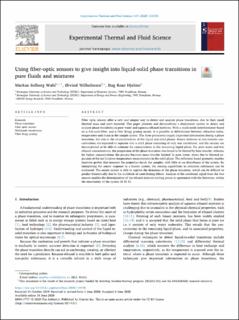| dc.contributor.author | Wahl, Markus Solberg | |
| dc.contributor.author | Wilhelmsen, Øivind | |
| dc.contributor.author | Hjelme, Dag Roar | |
| dc.date.accessioned | 2020-09-04T11:13:39Z | |
| dc.date.available | 2020-09-04T11:13:39Z | |
| dc.date.created | 2020-06-05T12:17:37Z | |
| dc.date.issued | 2020 | |
| dc.identifier.citation | Experimental Thermal and Fluid Science. 2020, 119 . | en_US |
| dc.identifier.issn | 0894-1777 | |
| dc.identifier.uri | https://hdl.handle.net/11250/2676421 | |
| dc.description.abstract | Fiber optic sensors offer a new and unique way to detect and analyze phase transitions, due to their small thermal mass and inert material. This paper presents and demonstrates a dual-sensor system to detect and analyze phase transitions in pure water and aqueous ethanol mixtures. With a multi-mode interferometer based on a thin-core fiber, and a fiber Bragg grating sensor, it is possible to differentiate between refractive index, temperature and strain in the sample system. The three parameters supply important information during a phase transition, but also in the characterization of the liquid and solid phases. Binary mixtures at non-eutectic concentrations are expected to separate into a solid phase consisting of only one constituent, and the sensors are demonstrated to be able to estimate the concentration in the remaining liquid phase. For pure water and low ethanol concentrations, the progression of the phase transition was found to be limited by heat transfer, whereas for higher concentrations the process becomes mass transfer limited. In pure water, strain due to thermal expansion of the ice hinderes temperature measurements in the solid phase. The reflection-based geometry enables insertion probes that measure the properties inside the samples, with little or no disturbance of the system. By interpreting the sensor response in a known system, the sensing capabilities in unknown substances can be evaluated. The sensor system is able to capture the dynamics of the phase transition, which can be difficult to predict theoretically due to the multitude of contributing effects. Analysis of the combined signal from the two sensors enables the determination of the ethanol mixture melting points in agreement with the literature, within the uncertainty of the system (0.25 K). © 2020 The Author(s) | en_US |
| dc.language.iso | eng | en_US |
| dc.publisher | Elsevier | en_US |
| dc.rights | Navngivelse 4.0 Internasjonal | * |
| dc.rights.uri | http://creativecommons.org/licenses/by/4.0/deed.no | * |
| dc.title | Using Fiber-Optic Sensors to Give Insight into Liquid-Solid Phase Transitions in Pure Fluids and Mixtures | en_US |
| dc.type | Peer reviewed | en_US |
| dc.type | Journal article | en_US |
| dc.description.version | publishedVersion | en_US |
| dc.source.pagenumber | 9 | en_US |
| dc.source.volume | 119 | en_US |
| dc.source.journal | Experimental Thermal and Fluid Science | en_US |
| dc.identifier.doi | 10.1016/j.expthermflusci.2020.110198 | |
| dc.identifier.cristin | 1814008 | |
| dc.description.localcode | © 2020 The Author(s). Published by Elsevier Inc. This is an open access article under the CC BY license (http://creativecommons.org/licenses/BY/4.0/). | en_US |
| cristin.ispublished | true | |
| cristin.fulltext | original | |
| cristin.qualitycode | 1 | |

